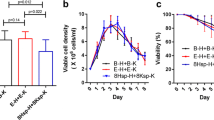Abstract
Human FcγRI (CD64) is an integral membrane glycoprotein functioning as a high-affinity receptor binding to monomeric IgG. In this study, the extracellular region of FcγRI, which is the actual part that interacts with IgG, was expressed as aglycosylated recombinant human FcγRI (rhFcγRI) in Escherichia coli. The soluble form of aglycosylated rhFcγRI was expressed in the periplasm of E. coli. The production of soluble aglycosylated rhFcγRI was increased by low induction levels. Furthermore, this production was increased by low translational efficiency, controlled by modification of the putative region between the ribosome binding site and initiation codon of rhFcγRI fusing signal peptide (MalE, PelB, or TorT) of the expression vector. By the optimization of induction and translational efficiency, the production of soluble aglycosylated rhFcγRI was up to approximately 0.8 mg/l of culture medium. Surface plasmon resonance analysis revealed that the binding affinities of aglycosylated rhFcγRI for human IgG1 (equilibrium dissociation constant K D = [1.7 ± 0.2] × 10−10 M) and IgG3 (K D = [1.1 ± 0.2] × 10−10 M) were similar to those of glycosylated rhFcγRI.




Similar content being viewed by others
References
Baraquet C, Théraulaz L, Guiral M, Lafitte D, Méjean V, Jourlin-Castelli C (2006) TorT, a member of a new periplasmic binding protein family, triggers induction of the Tor respiratory system upon trimethylamine N-oxide electron-acceptor binding in Escherichia coli. J Biol Chem 281:38189–38199
Barnes N, Gavin AL, Tan PS, Mottram P, Koentgen F, Hogarth PM (2002) FcγRI-deficient mice show multiple alterations to inflammatory and immune responses. Immunity 16:379–389
Bruhns P, Iannascoli B, England P, Mancardi DA, Fernandez N, Jorieux S, Daëron M (2009) Specificity and affinity of human Fcγ receptors and their polymorphic variants for human IgG subclasses. Blood 113:3716–3725
Chen H, Bjerknes M, Kumar R, Jay E (1994) Determination of the optimal aligned spacing between the Shine-Dalgarno sequence and the translation initiation codon of Escherichia coli mRNAs. Nucleic Acids Res 22:4953–4957
Dunn JJ, Buzash-Pollert E, Studier FW (1978) Mutations of bacteriophage T7 that affect initiation of synthesis of the gene 0.3 protein. Proc Natl Acad Sci USA 75:2741–2745
Ellsworth JL, Maurer M, Harder B, Hamacher N, Lantry M, Lewis KB, Rene S, Byrnes-Blake K, Underwood S, Waggie KS, Visich J, Lewis KE (2008) Targeting immune complex-mediated hypersensitivity with recombinant soluble human FcγRIA (CD64A). J Immunol 180:580–589
Georgiou G, Segatori L (2005) Preparative expression of secreted proteins in bacteria: status report and future prospects. Curr Opin Biotechnol 16:538–545
Hober S, Nord K, Linhult M (2007) Protein A chromatography for antibody purification. J Chromatogr B Analyt Technol Biomed Life Sci 848:40–47
Hoover DM, Lubkowski J (2002) DNAWorks: an automated method for designing oligonucleotides for PCR-based gene synthesis. Nucleic Acids Res 30:e43
Ioan-Facsinay A, de Kimpe SJ, Hellwig SMM, van Lent PL, Hofhuis FMA, van Ojik HH, Sedlik C, da Silveira SA, Gerber J, de Jong YF, Roozendaal R, Aarden LA, van den Berg WB, Saito T, Mosser D, Amigorena S, Izui S, van Ommen G-JB, van Vugt M, van de Winkel JGJ, Verbeek JS (2002) FcγRI (CD64) contributes substantially to severity of arthritis, hypersensitivity responses, and protection from bacterial infection. Immunity 16:391–402
Joller N, Weber SS, Oxenius A (2011) Antibody-Fc receptor interactions in protection against intracellular pathogens. Eur J Immunol 41:889–897
Jung ST, Kang TH, Georgiou G (2010) Efficient expression and purification of human aglycosylated Fcγ receptors in Escherichia coli. Biotechnol Bioeng 107:21–30
Kajava AV, Zolov SN, Kalinin AE, Nesmeyanova MA (2000) The net charge of the first 18 residues of the mature sequence affects protein translocation across the cytoplasmic membrane of Gram-negative bacteria. J Bacteriol 182:2163–2169
Lei S-P, Lin H-C, Wang S-S, Callaway J, Wilcox G (1987) Characterization of the Erwinia carotovora pelB gene and its product pectate lyase. J Bacteriol 169:4379–4383
Li P, Beckwith J, Inouye H (1988) Alteration of the amino terminus of the mature sequence of a periplasmic protein can severely affect protein export in Escherichia coli. Proc Natl Acad Sci USA 85:7685–7689
Lisi S, Sisto M, Lofrumento DD, D’Amore S, D’Amore M (2011) Advances in the understanding of the Fc gamma receptors-mediated autoantibodies uptake. Clin Exp Med 11:1–10
Makrides SC (1996) Strategies for achieving high-level expression of genes in Escherichia coli. Microbiol Rev 60:512–538
Paetz A, Sack M, Thepen T, Tur MK, Bruell D, Finnern R, Fischer R, Barth S (2005) Recombinant soluble human Fcγ receptor I with picomolar affinity for immunoglobulin G. Biochem Biophys Res Commun 338:1811–1817
Puziss JW, Strobel SM, Bassford PJ Jr (1992) Export of maltose-binding protein species with altered charge distribution surrounding the signal peptide hydrophobic core in Escherichia coli cells harboring prl suppressor mutations. J Bacteriol 174:92–101
Reth M (1989) Antigen receptor tail clue. Nature 338:383–384
Roberts TM, Bikel I, Yocum RR, Livingston DM, Ptashne M (1979) Synthesis of simian virus 40 t antigen in Escherichia coli. Proc Natl Acad Sci USA 76:5596–5600
Takai T (2002) Roles of Fc receptors in autoimmunity. Nat Rev Immunol 2:580–592
Thie H, Schirrmann T, Paschke M, Dübel S, Hust M (2008) SRP and Sec pathway leader peptides for antibody phage display and antibody fragment production in E. coli. N Biotechnol 25:49–54
Woof JM, Burton DR (2004) Human antibody-Fc receptor interactions illuminated by crystal structures. Nat Rev Immunol 4:89–99
Author information
Authors and Affiliations
Corresponding author
Electronic supplementary material
Below is the link to the electronic supplementary material.
ESM 1
(PDF 211 kb)
Rights and permissions
About this article
Cite this article
Hatayama, K., Asaoka, Y., Hoya, M. et al. Effective expression of soluble aglycosylated recombinant human Fcγ receptor I by low translational efficiency in Escherichia coli . Appl Microbiol Biotechnol 94, 1051–1059 (2012). https://doi.org/10.1007/s00253-012-3902-x
Received:
Revised:
Accepted:
Published:
Issue Date:
DOI: https://doi.org/10.1007/s00253-012-3902-x




